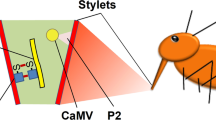Abstract
Crop plants genetically modified for herbicide tolerance were some of the first to be released into the environment. Frequently, the cauliflower mosaic virus (CaMV) 35S promoter is used to drive expression of the herbicide tolerance transgene. We analyzed the response to CaMV infection of a transgenic oilseed rape line containing the bialaphos tolerance gene (BAR) from Streptomyces hygroscopicus, regulated by the 35S promoter. Oilseed rape is susceptible to CaMV, but plants recover from infection. CaMV infection altered the expression of the herbicide tolerance gene such that plants became susceptible to the herbicide. The effect on transgene expression differed in infections with viral pathogenic variants typical of those found in natural situations worldwide. Susceptibility to the herbicide was most likely a result of transcriptional gene silencing of the transgene. Our results show that transgene phenotypes can be modified by pathogen invasion.
This is a preview of subscription content, access via your institution
Access options
Subscribe to this journal
Receive 12 print issues and online access
$209.00 per year
only $17.42 per issue
Buy this article
- Purchase on Springer Link
- Instant access to full article PDF
Prices may be subject to local taxes which are calculated during checkout




Similar content being viewed by others
References
Vaucheret, H. et al. Transgene-induced gene silencing in plants. Plant J. 16, 651–659 (1998).
Kooter, J.M., Matzke, M.A. & Meyer, P. Listening to the silent genes: transgene silencing, gene regulation and pathogen control. Trends Plant Sci. 4, 340–346 (1999).
Selker, E.U. Gene silencing: Repeats that count. Cell 97, 157–160 (1999).
Waterhouse, P.M., Smith, N.A. & Wang, M.B. Virus resistance and gene silencing: killing the messenger. Trends Plant Sci. 4, 452–457 (1999).
Baulcombe, D.C. Gene silencing: RNA makes RNA makes no protein. Curr. Biol. 9, 599–601 (1999).
Covey, S.N., Al-Kaff, N.S., Lángara, A. & Turner D.S. Plant combat infection by gene silencing. Nature 385, 781–782 (1997).
Ratcliff, F., Harrison, B.D. & Baulcombe, D.C. A similarity between viral defense and gene silencing in plants. Science 276, 1558–1560 (1997).
Al-Kaff, N.S. et al. Transcriptional and post-transcriptional plant gene silencing in response to a pathogen. Science 279, 2113–2115 (1998).
Covey, S.N., Lomonossoff, G.P. & Hull, R. Characterisation of cauliflower mosaic virus DNA sequences which encode major polyadenylated transcripts. Nucleic Acids Res. 24, 6735–6747 (1981).
Odell, J.T., Nagy, F. & Chua, N-H. Identification of DNA sequences required for activity of the cauliflower mosaic virus 35S promoter. Nature 313, 810–812 (1985).
Benfey, P.N. & Chua, N-H. The cauliflower mosaic virus 35S promoter: combinatorial regulation of transcription in plants. Science 250, 959–966 (1990).
Shepherd, R.J. DNA plant viruses. Ann. Rev. Plant Physiol. 30, 405–423 (1979).
Tomlinson, J.A. Epidemiology and control of virus diseases of vegetables. Ann. Appl. Biol. 110, 661–681 (1987).
Hardwick, N.V., Davies, J.M.L. & Wright, D.M. The incidence of three virus diseases of winter oilseed rape in England and Wales in the 1991/92 and 1992/93 growing seasons. Plant Pathol. 43, 1045–1049 (1994).
Raybould, A.F., Maskell, L.C., Edwards, M.L., Cooper, J.I. & Gray, A.J. The prevalence and spatial distribution of viruses in natural populations of Brassica oleracea. New Phytol. 141, 265–275 (1999).
Jones, J.D.G. et al. Effective vectors for transformation, expression of heterologous and assaying transposon excision in transgenic plants. Transgenic Res. 1, 285–297 (1992).
Hull, R. Structure of cauliflower mosaic virus genome. III. Restriction endonuclease mapping of thirty-three isolates. Virology 100, 76–90 (1980).
Al-Kaff, N.S. & Covey, S.N. Biological diversity of cauliflower mosaic virus isolates expressed in two Brassica species. Plant Pathol. 44, 516–526 (1995).
Saunders, K., Lucy, A.P. & Covey, S.N. Susceptibility of Brassica species to cauliflower mosaic virus infection is related to a specific stage in the virus multiplication cycle. J. Gen. Virol. 71, 1641–1647 (1990).
Covey, S.N., Turner, D.S., Lucy, A.P. & Saunders, K. Host regulation of cauliflower mosaic virus. Proc. Natl. Acad. Sci. USA 87, 1633–1637 (1990).
Qin, X.F., Holuigue, L., Horvath, D.M. & Chua, N.H. Immediate-early transcription activation by salicylic acid via the cauliflower mosaic virus AS-1 element. Plant Cell 6, 863–874 (1994).
De Block, M. et al. Engineering herbicide tolerance in plants by expression of a detoxifying enzyme. EMBO J. 6, 2513–2518 (1987).
Acknowledgements
We thank Non Owen and Chris Jones for producing the transgenic lines and J. Jones for providing the transgene constructs. We also thank R. Hull, C. Jenner, and J. Walsh for CaMV variants, and Mike Hill for treating plants with the herbicide. We gratefully acknowledge funds provided by Food Standards Agency FSA (FS0230) and the BBSRC. The work was carried out under MAFF license PHL 11B/3013(3/1999).
Author information
Authors and Affiliations
Corresponding author
Rights and permissions
About this article
Cite this article
Al-Kaff, N., Kreike, M., Covey, S. et al. Plants rendered herbicide-susceptible by cauliflower mosaic virus–elicited suppression of a 35S promoter-regulated transgene. Nat Biotechnol 18, 995–999 (2000). https://doi.org/10.1038/79501
Received:
Accepted:
Issue Date:
DOI: https://doi.org/10.1038/79501
This article is cited by
-
Novel strong promoter of antimicrobial peptides gene pro-SmAMP2 from chickweed (Stellaria media)
BMC Biotechnology (2016)
-
Cotton leaf curl Multan betasatellite as a plant gene delivery vector trans-activated by taxonomically diverse geminiviruses
Archives of Virology (2012)
-
Characterization of a field-grown transgenic pineapple clone containing the genes chitinase, AP24, and bar
In Vitro Cellular & Developmental Biology - Plant (2010)
-
Biochemical side effects of genetic transformation of pineapple
Plant Cell, Tissue and Organ Culture (2006)
-
Isolation and characterization of a novel plant promoter that directs strong constitutive expression of transgenes in plants
Molecular Breeding (2005)



